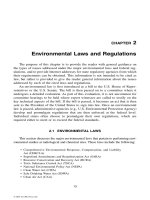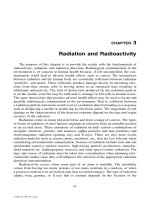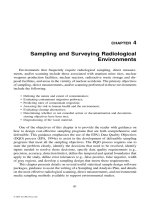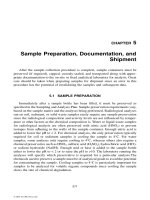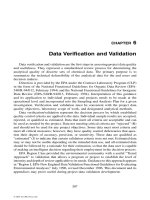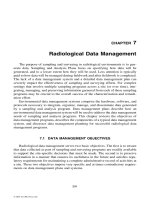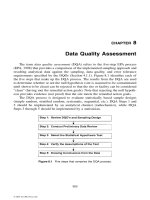SAMPLING AND SURVEYING RADIOLOGICAL ENVIRONMENTS - CHAPTER 10 (end) potx
Bạn đang xem bản rút gọn của tài liệu. Xem và tải ngay bản đầy đủ của tài liệu tại đây (524.69 KB, 72 trang )
A-1
APPENDIX
A
Data Quality Objectives Summary
Report Template*
Data Quality Objectives
Summary Report for
[Add Project Description]
Prepared for the [Note: Insert name of organization]
Submitted by [Note: Add company name]
* Appendix A appears on the CD accompanying this book.
© 2001 by CRC Press LLC
A-2 SAMPLING AND SURVEYING RADIOLOGICAL ENVIRONMENTS
Data Quality Objectives Summary
Report for [Add Project Description]
Author(s)
[Add Author Name(s)]
[Add Company Name(s)]
Date Published
[Add Publication Date]
© 2001 by CRC Press LLC
DATA QUALITY OBJECTIVES SUMMARY REPORT TEMPLATE A-3
Executive Summary
[Insert executive summary text here.]
© 2001 by CRC Press LLC
A-4 SAMPLING AND SURVEYING RADIOLOGICAL ENVIRONMENTS
Contents
1.0 Step 1 – State the Problem A-9
1.1 Project Objectives A-9
1.2 Project Assumptions A-9
1.3 Project Issues A-9
1.3.1 Global Issues A-9
1.4 Existing References A-10
1.5 Site Background Information A-10
1.6 DQO Team Members and Regulators A-10
1.7 Project Budget and Contractual Vehicles A-11
1.8 Milestone Dates A-12
1.9 Contaminants of Concern A-12
1.9.1 Total List of Contaminants of Potential Concern A-12
1.9.2 Contaminants of Potential Concern Addressed by
Concurrent Remediation Activities A-12
1.9.3 Other Contaminant of Potential Concern
Exclusions A-13
1.9.4 Final List of Contaminants of Concern A-14
1.9.5 Distribution of Contaminants of Concern A-14
1.10 Current and Potential Future Land Use A-14
1.11 Conceptual Site Model A-14
1.12 Statement of the Problem A-15
2.0 Step 2—Identify the Decision A-17
3.0 Step 3—Identify Inputs to the Decision A-19
3.1 Information Required to Resolve Decision Statements A-19
3.2 Basis for Setting the Action Level A-19
3.3 Computational and Survey/Analytical Methods A-20
3.4 Analytical Performance Requirements A-21
4.0 Step 4—Define the Boundaries of the Study A-23
4.1 Population of Interest A-23
4.2 Geographic Boundaries A-23
4.3 Zones With Homogeneous Characteristics A-24
4.4 Temporal Boundaries A-24
4.5 Scale of Decision Making A-25
4.6 Practical Constraints A-25
5.0 Step 5—Develop a Decision Rule A-27
5.1 Inputs Needed to Develop Decision Rules A-27
5.2 Decision Rules A-28
6.0 Step 6—Specify Tolerable Limits on Decision Errors A-29
6.1 Statistical vs. Nonstatistical Sampling Design A-29
6.2 Nonstatistical Designs A-29
6.3 Statistical Designs A-30
6.4 Decision Errors A-30
© 2001 by CRC Press LLC
DATA QUALITY OBJECTIVES SUMMARY REPORT TEMPLATE A-5
6.5 Null Hypothesis A-30
6.6 Tolerable Limits for Decision Error A-31
7.0 Step 7—Optimize the Design A-33
7.1 Nonstatistical Design A-33
7.1.1 Nonstatistical Screening Method Alternatives A-33
7.1.2 Nonstatistical Sampling Method Alternatives A-33
7.1.3 Nonstatistical Implementation Design A-34
7.2 Statistical Design A-34
7.2.1 Data Collection Design Alternatives A-34
7.2.2 Mathematical Expressions for Solving Design
Problems A-34
7.2.3 Select the Optimal Sample/Measurement Size That
Satisfies the DQO A-35
7.2.4 Sampling/Measurement Cost A-38
7.2.5 Selecting the Most Resource-Effective Data
Collection Design A-38
7.2.6 Final Statistical Sampling Design A-38
8.0 References A-41
© 2001 by CRC Press LLC
A-6 SAMPLING AND SURVEYING RADIOLOGICAL ENVIRONMENTS
Tables
1-1 Existing References A-10
1-2 DQO Team Members A-11
1-3 Regulators A-11
1-4 Task Budget and Contractual Vehicles A-11
1-5 Milestone Dates A-12
1-6 Total List of COPCs for Each Media Type A-13
1-7 COPCs Addressed by Concurrent Remediation Activities A-13
1-8 Rationale for COPC Exclusions A-13
1-9 Final List of COCs A-14
1-10 Distribution of COCs A-14
1-11 Current and Potential Future Land Use A-15
1-12 Tabular Depiction of the Conceptual Site Model A-15
2-1 Summary of DQO Step 2 Information A-18
3-1 Required Information and Reference Sources A-19
3-2 Basis for Setting Action Level A-20
3-3 Information Required to Resolve the Decision Statements A-20
3-4 Details on Identified Computational Methods A-20
3-5 Potentially Appropriate Survey/Analytical Methods A-21
3-6 Analytical Performance Requirements A-21
4-1 Characteristics That Define the Population of Interest A-23
4-2 Geographic Boundaries of the Investigation A-24
4-3 Zones with Homogeneous Characteristics A-24
4-4 Temporal Boundaries of the Investigation A-24
4-5 Scale of Decision Making A-25
4-6 Practical Constraints on Data Collection A-25
5-1 Decision Statements A-27
5-2 Inputs Needed to Develop Decision Rules A-27
5-3 Decision Rules A-28
6-1 Statistical vs. Nonstatistical Sampling Design A-29
6-2 Statistical Parameter of Interest Concentration Ranges A-30
6-3 Defining the Null Hypothesis A-30
6-4 Statistical Designs A-31
6-5 Tolerable Decision Errors A-31
7-1 Potential Nonstatistical Screening Alternatives A-33
7-2 Potential Nonstatistical Sampling Method Alternatives A-34
7-3 Selected Implementation Design A-35
7-4 Selected Statistical Design A-36
7-5 Statistical Methods for Testing the Null Hypothesis A-36
7-6 Sample/Measurement Size Based on Varying Error Tolerances
and LBGR A-37
7-7 Sampling Cost Based on Varying Error Tolerances and LBGR A-39
7-8 Most Resource Effective Data Collection Design A-40
7-9 Final Statistical Sampling/Measurement Design A-40
© 2001 by CRC Press LLC
DATA QUALITY OBJECTIVES SUMMARY REPORT TEMPLATE A-7
Acronyms
[List all of the acronyms used in the workbook. The following list is only an
example.]
COC contaminant of concern
COPC contaminant of potential concern
D&D decontamination and decommissioning
DQO data quality objective
DR decision rule
DS decision statement
EPA U.S. Environmental Protection Agency
LBGR lower bound of the gray region
PQL practical quantitation limit
PSQ principal study question
SAP sampling and analysis plan
UCL upper confidence level
WS waste stream
© 2001 by CRC Press LLC
A-8 SAMPLING AND SURVEYING RADIOLOGICAL ENVIRONMENTS
Metric Conversion Chart
Into Metric Units Out of Metric Units
If You Know Multiply By To Get If You Know Multiply By To Get
Length Length
inches 25.4 millimeters millimeters 0.039 inches
inches 2.54 centimeters centimeters 0.394 inches
feet 0.305 meters meters 3.281 feet
yards 0.914 meters meters 1.094 yards
miles 1.609 kilometers kilometers 0.621 miles
Area Area
sq. inches 6.452 sq. centimeters sq. centimeters 0.155 sq. inches
sq. feet 0.093 sq. meters sq. meters 10.76 sq. feet
sq. yards 0.0836 sq. meters sq. meters 1.196 sq. yards
sq. miles 2.6 sq. kilometers sq. kilometers 0.4 sq. miles
acres 0.405 hectares hectares 2.47 acres
Mass (weight) Mass (weight)
ounces 28.35 grams grams 0.035 ounces
pounds 0.454 kilograms kilograms 2.205 pounds
ton 0.907 metric ton metric ton 1.102 ton
Volume Volume
teaspoons 5 milliliters milliliters 0.033 fluid ounces
tablespoons 15 milliliters liters 2.1 pints
fluid ounces 30 milliliters liters 1.057 quarts
cups 0.24 liters liters 0.264 gallons
pints 0.47 liters cubic meters 35.315 cubic feet
quarts 0.95 liters cubic meters 1.308 cubic yards
gallons 3.8 liters
cubic feet 0.028 cubic meters
cubic yards 0.765 cubic meters
Temperature Temperature
Fahrenheit Subtract 32,
then multiply
by 5/9
Celsius Celsius Multiply by
9/5, then
add 32
Fahrenheit
Radioactivity Radioactivity
picocuries 37 millibecquerel millibecquerel 0.027 picocuries
© 2001 by CRC Press LLC
DATA QUALITY OBJECTIVES SUMMARY REPORT TEMPLATE A-9
1.0 Step 1— State the Problem
The purpose of this data quality objective (DQO) process is to support decision-
making activities as they pertain to the remediation of [Note: Add the name of the
site to be remediated]. The objective of DQO Step 1 is to use the information
gathered from the DQO scoping process, as well as other relevant information to
state the problem to be resolved clearly and concisely. The free-form text sections
included in this step are intended to define the task objectives and assumptions,
present the task issues, summarize the site background information, and provide a
concise statement of the problem. The tables provided in this section are designed
to document the personnel involved in the DQO process, identify the contaminants
of concern, and summarize the key information needed to support the writing of the
problem statement.
1.1 PROJECT OBJECTIVES
[Note on completion of Section 1.1: Clearly state the task objectives as they
pertain to remediation activities. Begin discussing the task objectives on a large
scale, then focus the discussion on the site-specific objectives.]
1.2 PROJECT ASSUMPTIONS
[Note on completion of Section 1.2: Clearly state all of the task-specific assump-
tions that have been made based on DQO Team discussions and interviews with the
regulators.]
1.3 PROJECT ISSUES
1.3.1 Global Issues
[Note on completion of Section 1.3.1: Present the date when the global issues
meeting was held, and note the organizations that were represented at the meeting.
List each of the global issues that were discussed and the resolutions that were
agreed upon.]
© 2001 by CRC Press LLC
A-10 SAMPLING AND SURVEYING RADIOLOGICAL ENVIRONMENTS
1.4 EXISTING REFERENCES
Table 1-1 presents a list of all of the references that were reviewed as part of
the scoping process, as well as a summary of the pertinent information contained
within each reference. These references are the primary source for the background
information presented in Section 1.5.
1.5 SITE BACKGROUND INFORMATION
[Note on completion of Section 1.5: In this section, provide background infor-
mation about the site under investigation. This information will be used to support
the development of the problem statement. This section should address the following
key areas:
• Site description
• Site history
• Specific areas within the site to be investigated
• Summary of all recorded spills and releases
• Summary of historical analytical data.]
1.6 DQO TEAM MEMBERS AND REGULATORS
Individual members of the DQO Team were carefully selected to participate in
the seven-step DQO process based on their technical background to provide expertise
in all of the technical areas needed to meet the task objectives. The regulators
included representatives from the [Note: Insert the name of the regulatory agencies].
The role of the regulators was to make final decisions related to the sampling design.
Tables 1-2 and 1-3 identify each of the individual members of the DQO team
and the regulators. These tables also identify the organization that each DQO team
member or regulator represents, as well as their technical area of expertise and
telephone number.
Table 1-1 Existing References
Reference Summary
© 2001 by CRC Press LLC
DATA QUALITY OBJECTIVES SUMMARY REPORT TEMPLATE A-11
1.7 PROJECT BUDGET AND CONTRACTUAL VEHICLES
Table 1-4 presents the budget for all of the task activities associated with the
development and implementation of the sampling program, the performance of
laboratory analyses, the performance of the data quality assessment, and the evalu-
ation and reporting of investigation results. For those activities that need to be
subcontracted, Table 1-4 presents the available contractual vehicles.
Table 1-2 DQO Team Members
Name Organization Role and Responsibility
Telephone
Number
Table 1-3 Regulators
Name Organization
Role and
Responsibility Telephone Number
Table 1-4 Task Budget and Contractual Vehicles
Task Activities Budget Contractual Vehicle
DQO development
Sampling and analysis plan development
Field implementation
Laboratory analyses
Data quality assessment
Documentation of investigation results
© 2001 by CRC Press LLC
A-12 SAMPLING AND SURVEYING RADIOLOGICAL ENVIRONMENTS
1.8 MILESTONE DATES
Table 1-5 presents the milestone dates for the completion of all of the task
activities associated with the development and implementation of the sampling
program, the performance of laboratory analyses, the performance of a data quality
assessment, and the evaluation and reporting of investigation results.
1.9 CONTAMINANTS OF CONCERN
A list of the contaminants of concern (COCs) for the site under investigation
was generated by initially listing all of the contaminants of potential concern
(COPCs) based on historical process operations. Certain COPCs were then removed
from the list if they were being addressed under either a separate sampling and
analysis plan (SAP) or a waste management plan. Certain COPCs may also have
been removed if they have a short half-life, are not regulated, pose no risk, or are
nontoxic, or if process knowledge/analytical data confirms that insignificant releases
have occurred.
1.9.1 Total List of Contaminants of Potential Concern
Table 1-6 identifies all of the COPCs for each of the types of media to undergo
remediation.
1.9.2 Contaminants of Potential Concern Addressed by Concurrent
Remediation Activities
The scope of a DQO prepared in support of remediation activities typically
assumes the responsibility for all media at the site. However, if certain media and
associated COPCs are already being addressed by concurrent activities (i.e., under
a separate SAP or waste management plan), these media/associated COPCs may be
excluded from further consideration from this DQO. Table 1-7 presents a list of the
COPCs that are being removed from the total list of COPCs for this reason.
Table 1-5 Milestone Dates
Task Activities Milestone Date
DQO workbook development
Sampling and analysis plan development
Field implementation
Laboratory analyses
Data quality assessment
Documentation of investigation results
© 2001 by CRC Press LLC
DATA QUALITY OBJECTIVES SUMMARY REPORT TEMPLATE A-13
1.9.3 Other Contaminant of Potential Concern Exclusions
Table 1-8 presents a list of all other COPCs to be excluded from the investigation.
These exclusions are in addition to the exclusions identified in Table 1-7 and are
based on physical laws, process knowledge, task focus, or other mitigating factors.
Table 1-8 provides the specific rationale for the exclusion of each of the identified
COPCs.
Table 1-6 Total List of COPCs for Each Media Type
Media
Known or
Suspected Source
of Contamination
Type of
Contamination
(General)
COPCs
(Specific)
Table 1-7 COPCs Addressed by Concurrent Remediation Activities
Media COPCs Remediation Activity
Table 1-8 Rationale for COPC Exclusions
Media COPCs Rationale for Exclusion
© 2001 by CRC Press LLC
A-14 SAMPLING AND SURVEYING RADIOLOGICAL ENVIRONMENTS
1.9.4 Final List of Contaminants of Concern
Table 1-9 presents the final list of COCs for each media to be carried through
the remainder of the DQO process.
1.9.5 Distribution of Contaminants of Concern
Table 1-10 identifies the best understanding of how each of the COCs arrived at
the site and the fate and transport mechanisms (e.g., wind or water) that may have
impacted the distribution (e.g., layering or lateral homogeneity) of each of the COCs.
1.10 CURRENT AND POTENTIAL FUTURE LAND USE
The current and potential future uses for the land in the immediate vicinity of
the site under investigation are summarized in Table 1-11. This information is needed
later in the DQO process to support the evaluation of decision error consequences.
1.11 CONCEPTUAL SITE MODEL
The goal of the DQO process is to develop a sampling design that will either
confirm or reject the conceptual site model. The conceptual site model is continu-
ously being refined as more data become available. Table 1-12 presents a tabular
Table 1-9 Final List of COCs
Media COCs
Table 1-10 Distribution of COCs
Media COCs
How COC
Arrived at Site
Fate and
Transport
Mechanisms
Expected
Distribution
(Heterogeneous/
Homogeneous)
© 2001 by CRC Press LLC
DATA QUALITY OBJECTIVES SUMMARY REPORT TEMPLATE A-15
depiction of the conceptual site model, identifying the sources, release mechanisms,
migration pathways, and potential receptors for each of the COCs. This table also
summarizes the exposure scenarios.
1.12 STATEMENT OF THE PROBLEM
[Note on completion of Section 1.12: Combine the relevant background infor-
mation into a concise statement of the problem to be resolved in a descriptive text
format. The problem description should be concise but comprehensive. This discus-
sion should be a comprehensive summary of the problem to be resolved and should
provide a textual description of the information provided in the previous tables,
particularly Table 1-12.]
Table 1-11 Current and Potential Future Land Use
Current Land Use Potential Future Land Use
Table 1-12 Tabular Depiction of the Conceptual Site Model
Media COCs Source
Release
Mechanism
Migration
Pathways
Potential
Receptors
Exposure Scenario:
Exposure Scenario:
© 2001 by CRC Press LLC
DATA QUALITY OBJECTIVES SUMMARY REPORT TEMPLATE A-17
2.0 Step 2— Identify the Decision
The purpose of DQO Step 2 is to define the principal study questions (PSQs)
that need to be resolved to address the problem identified in DQO Step 1 and the
alternative actions that would result from the resolution of the PSQs. The PSQs and
alternative actions are then combined into decision statements that express a choice
among alternative actions. Table 2-1 presents the task-specific PSQs, alternative
actions, and resulting decision statements. This table also provides a qualitative
assessment of the severity of the consequences of taking an alternative action if it
is incorrect. This assessment takes into consideration human health, environment
(flora/fauna), political, economic, and legal ramifications. The severity of the con-
sequences is expressed as low, moderate, or severe.
© 2001 by CRC Press LLC
A-18 SAMPLING AND SURVEYING RADIOLOGICAL ENVIRONMENTS
Table 2-1 Summary of DQO Step 2 Information
PRINCIPAL STUDY QUESTION #1—
PSQ
-AA# Alternative Action
Description of
Consequences of
Implementing the
Wrong Alternative
Action
Severity of
Consequences
(Low/Moderate/Severe)
Decision Statement #1—
PRINCIPAL STUDY QUESTION #2—
PSQ
-AA# Alternative Action
Description of
Consequences of
Implementing the
Wrong Alternative
Action
Severity of
Consequences
(Low/Moderate/Severe)
Decision Statement #2—
PRINCIPAL STUDY QUESTION #3—
PSQ
-AA# Alternative Action
Description of
Consequences of
Implementing the
Wrong Alternative
Action
Severity of
Consequences
(Low/Moderate/Severe)
Decision Statement #3—
© 2001 by CRC Press LLC
DATA QUALITY OBJECTIVES SUMMARY REPORT TEMPLATE A-19
3.0 Step 3 – Identify Inputs to the Decision
The purpose of DQO Step 3 is to identify the type of data needed to resolve
each of the decision statements identified in DQO Step 2. This data may already
exist or may be derived from computational or surveying/sampling and analysis
methods. Analytical performance requirements (e.g., practical quantitation limit, or
PQL, requirement, precision, and accuracy) are also provided in this step for any
new data that need to be collected.
3.1 INFORMATION REQUIRED TO RESOLVE DECISION STATEMENTS
Table 3-1 specifies the information (data) required to resolve each of the decision
statements identified in Table 2-1 and identifies whether these data already exist.
For the data that are identified as existing, the source references for the data have
been provided with a qualitative assessment as to whether or not the data are of
sufficient quality to resolve the corresponding decision statement. The qualitative
assessment of the existing data was based on the evaluation of the corresponding
quality control data (e.g., spikes, duplicates, blanks), detection limits, data collection
methods, etc.
3.2 BASIS FOR SETTING THE ACTION LEVEL
The action level is the threshold value that provides the criterion for choosing
between alternative actions. Table 3-2 identifies the basis (i.e., regulatory threshold
or risk-based) for establishing the action level for each of the COCs. The numerical
value for the action level is defined in DQO Step 5.
Table 3-1 Required Information and Reference Sources
DS
#
Remediation
Variable
Required
Data
Does
Data
Exist?
(Y/N)
Source
Reference
Sufficient
Quality
(Y/N)
Additional
Information
Required?
(Y/N)
© 2001 by CRC Press LLC
A-20 SAMPLING AND SURVEYING RADIOLOGICAL ENVIRONMENTS
3.3 COMPUTATIONAL AND SURVEY/ANALYTICAL METHODS
Table 3-3 identifies the decision statements where existing data either do not
exist or are of insufficient quality to resolve the decision statements. For these
decision statements, Table 3-3 presents computational and/or surveying/sampling
methods that could be used to obtain the required data.
Table 3-4 presents details on the computational methods identified in Table 3-3.
These details include the source and/or author of the computational method and
information on how the method could be applied to this study.
Table 3-2 Basis for Setting Action Level
DS #
Remediation
Variable COCs
Basis for Setting Action
Level
Table 3-3 Information Required to Resolve the Decision Statements
DS #
Remediation
Variable Required Data
Computational
Methods
Survey/Analytical
Methods
Table 3-4 Details on Identified Computational Methods
DS #
Computational
Method Source/Author
Application to
Study
© 2001 by CRC Press LLC
DATA QUALITY OBJECTIVES SUMMARY REPORT TEMPLATE A-21
Table 3-5 identifies each of the survey and/or analytical methods that may be
used to provide the required information needed to resolve each of the decision
statements. The possible limitations associated with each of these methods are also
provided with the estimated cost.
3.4 ANALYTICAL PERFORMANCE REQUIREMENTS
Table 3-6 defines the analytical performance requirements for the data that need
to be collected to resolve each of the decision statements. These performance require-
ments include the PQL and precision and accuracy requirements for each of
the COCs.
Table 3-5 Potentially Appropriate Survey/Analytical Methods
DS #
Remediation
Variable
Potentially
Appropriate
Survey/ Analytical
Method
Possible
Limitations Cost
Table 3-6 Analytical Performance Requirements
DS # COCs
Survey/
Analytical
Method
Preliminary
Action Level PQL
Precision
Requirement
Accuracy
Requirement
© 2001 by CRC Press LLC
DATA QUALITY OBJECTIVES SUMMARY REPORT TEMPLATE A-23
4.0 Step 4— Define the Boundaries
of the Study
The primary objective of DQO Step 4 is to identify the population of interest,
define the spatial and temporal boundaries that apply to each decision statement,
define the scale of decision making, and identify any practical constraints (hindrances
or obstacles) that must be taken into consideration in the sampling design. Imple-
menting this step ensures that the sampling design will result in the collection of
data that accurately reflect the true condition of the site under investigation.
4.1 POPULATION OF INTEREST
Prior to defining the spatial and temporal boundaries of the site under investi-
gation, it is first necessary to define clearly the populations of interest that apply for
each decision statement (Table 4-1). The intent of Table 4-1 is to clearly define the
attributes that make up each population of interest by stating them in a way that
makes the focus of the study unambiguous.
4.2 GEOGRAPHIC BOUNDARIES
Table 4-2 identifies the geographic boundaries that apply to each decision state-
ment. Limiting the geographic boundaries of the study area ensures that the inves-
tigation does not expand beyond the original scope of the task.
Table 4-1 Characteristics that Define the Population of Interest
DS # Population of Interest Unit Measurement Size
Total Number of
Potential Measurement
Units within the
Population
© 2001 by CRC Press LLC
A-24 SAMPLING AND SURVEYING RADIOLOGICAL ENVIRONMENTS
4.3 ZONES WITH HOMOGENEOUS CHARACTERISTICS
Table 4-3 defines the zones within the site under investigation that have relatively
homogeneous characteristics. These zones were identified by using existing infor-
mation to segregate the elements of the population into subsets that exhibit relatively
homogeneous characteristics (e.g., types of contaminants). Dividing the site into
separate zones reduces the overall complexity of the problem by breaking the site
into more manageable pieces.
4.4 TEMPORAL BOUNDARIES
Table 4-4 identifies temporal boundaries that may apply to each decision state-
ment. The temporal boundary refers to both the time frame over which each decision
statement applies (e.g., number of years) and when (e.g., season, time of day, weather
conditions) the data should optimally be collected.
Table 4-2 Geographic Boundaries of the Investigation
DS # Geographic Boundaries of the Investigation
Table 4-3 Zones with Homogeneous Characteristics
DS # Population of Interest Zone
Homogeneous
Characteristic Logic
Table 4-4 Temporal Boundaries of the Investigation
DS # Time Frame When to Collect Data
© 2001 by CRC Press LLC
DATA QUALITY OBJECTIVES SUMMARY REPORT TEMPLATE A-25
4.5 SCALE OF DECISION MAKING
In Table 4-5, the scale of decision making has been defined for each decision
statement. The scale of decision making is defined by joining the population of
interest and the geographic and temporal boundaries of the area under investigation.
4.6 PRACTICAL CONSTRAINTS
Table 4-6 identifies all of the practical constraints that may impact the data
collection effort. These constraints include physical barriers, difficult sample matri-
ces, high radiation areas, or any other condition that will need to be taken into
consideration in the design and scheduling of the sampling program.
Table 4-5 Scale of Decision Making
Temporal Boundary
DS #
Population of
Interest
Geographic
Boundary
Time
Frame
When to
Collect Data
Scale of
Decision
Table 4-6. Practical Constraints on Data Collection
© 2001 by CRC Press LLC
DATA QUALITY OBJECTIVES SUMMARY REPORT TEMPLATE A-27
5.0 Step 5— Develop a Decision Rule
The purpose of DQO Step 5 is initially to define the statistical parameter of
interest (i.e., mean, median) that will be used for comparison against the action level.
The statistical parameter of interest specifies the characteristic or attribute that the
regulator would like to know about the population. The final action level for each
of the COCs is also identified in DQO Step 5. When this is established, a decision
rule is developed for each decision statement in the form of an “if … then …”
statement that incorporates the parameter of interest, the scale of decision making,
the action level, and the alternative action(s) that would result from resolution of
the decision. Note that the scale of decision making and alternative actions were
identified earlier in DQO Steps 4 and 2, respectively.
5.1 INPUTS NEEDED TO DEVELOP DECISION RULES
Tables 5-1 and 5-2 present all of the information needed to formulate the decision
rules identified in Section 5.2. This information includes the decision statements and
alternative actions identified earlier in DQO Step 2, the scale of decision making
identified in DQO Step 4, the statistical parameter of interest, and the final action
levels for each of the COCs.
Table 5-1 Decision Statements
DS # Decision Statement
Table 5-2 Inputs Needed to Develop Decision Rules
DS# COCs
Statistical
Parameter
of Interest
Scale of
Decision
Making
Final Action
Level
Alternative
Actions
© 2001 by CRC Press LLC
A-28 SAMPLING AND SURVEYING RADIOLOGICAL ENVIRONMENTS
5.2 DECISION RULES
Table 5-3 presents decision rules that correspond to each of the decision state-
ments identified in Table 5-1.
Table 5-3 Decision Rules
DS # DR # Decision Rule
© 2001 by CRC Press LLC



